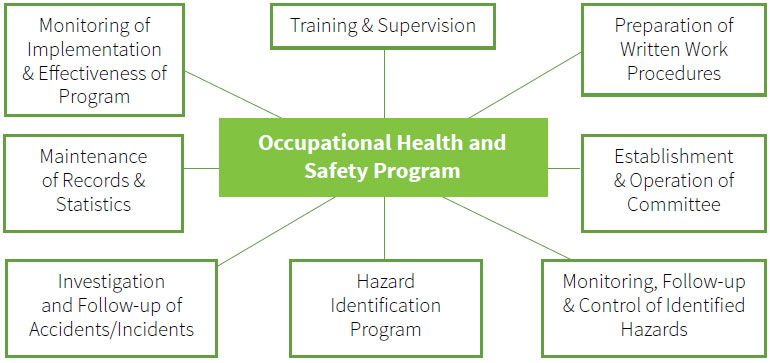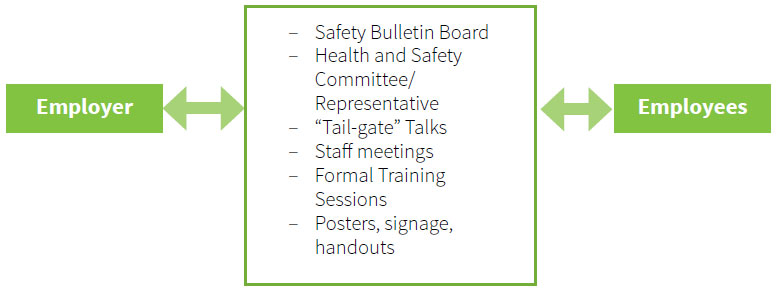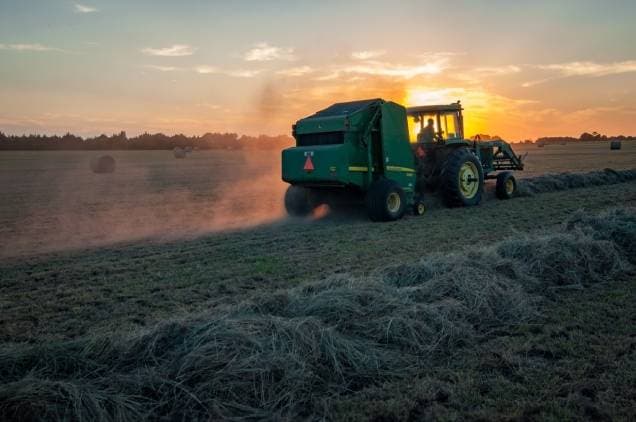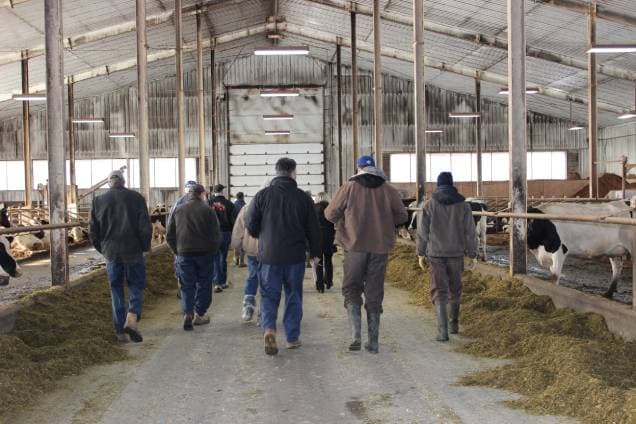
Section Two: Get Started
Workbook
Confirm your Commitment
To-Do:
- Complete a self-assessment
- Develop Farm OHS Policy
- Select Health and Safety Representative (5-19 employees)
- Select Health and Safety Committee (20 or more employees)
- Develop rules of procedure for the Committee
- Address posting requirements
Like any task that you have undertaken, you need continued commitment to see it through. Understand that you may encounter challenges and frustrations along the way while building a farm safety plan, but know that the results will make your efforts worthwhile.
Show your commitment
Let everyone know you are committed to the health and safety of your workers.
Post your health and safety information (examples of which we will outline in this manual) throughout your farm, in visible locations which could include:
- Entryway
- Lunchroom
- Common room
Live your commitment
Celebrate a good safety record at your workplace:
- Set a goal just beyond your current record and celebrate with your workers when you achieve it.
- Recognize a worker or team for their safety record at a workplace meeting.
- Recognize workers for their ideas on improving safety.
Tips for making safety a workplace priority
- Make positive attitudes and proven safe work practices a condition of hiring.
- Make new workers aware of your safety policy as part of the hiring process.
- Make safety a part of all management, supervisor, and worker evaluations.
- Put workplace safety on the agenda at group meetings.
For the purpose of this manual, we’ve provided definitions of both
a Farm Safety Plan and a Health and Safety Program:
A farm safety plan is a farm specific, practical plan that will help you improve the safety on your farm by identifying the hazards, controls and day-to-day protocols required to stay safe. Every farm should have a farm safety plan in place. The information and processes within the plan will differ from farm-to-farm, taking into account each farm’s unique operation and size.
A farm safety plan differs from a health and safety program. The term “program” is a regulatory term defined by the OH&S legislation. A health and safety program is required by farms which employ 20 or more workers and the Act outlines in detail which items must be included in a program for your farm. For all farms with over 20 employees, their health and safety program becomes their farm safety plan.
Every farm should have a farm safety plan, regardless of its size. The details of that plan will depend on the nature of your unique farm operation. The first step in developing that personal plan begins with adopting a commitment to safety, and
that commitment comes from combining a personal and sincere obligation to the well-being of your employees and your family with good business sense.
This section will provide an overview on:
- Determining a baseline of your current workplace health and safety structure.
- The roles and responsibilities within the farm organization.
- Health and Safety Representative and an Occupational Health and Safety Committee.
- Building a unique workplace health and safety plan.
- Communications.
So, how do you get started? The best place is to determine where you currently stand.
Conducting a “Self-Assessment”
Establishing the effectiveness of your current workplace health and safety efforts can be done by conducting a “self-assessment” of your work environment. This assessment will provide you with a clear picture on the effectiveness of your current workplace safety measures, and what steps you need to take to improve.
Canada’s Farm Safe Plan, developed by the Canadian Agricultural Safety Association, provides a helpful guide to take you through such an assessment.
It looks at a few aspects of a workplace including:
- Philosophy
- Policy
- Procedures
- Practices
- People

You can find an example of this self-assessment exercise in your workbook.
Once this self-assessment has been completed, it will provide you with a picture of what you’re doing well, and where you need to address some gaps in farm health and safety. From here you can build your farm safety plan.
Overview of a Farm Safety Plan
A farm safety plan should be developed with the full participation of your workforce. This will empower your team to take responsibility for their safety and the safety of their co-workers, while also making sure they are aware of the expectations from the get-go. A written plan could include the following sections:
1. General Policy Statement: Develop and communicate an overall policy on health and safety with supporting operational policies.
2. Identify Hazards: Identify existing and potential hazards in all aspects of your operation.
3. Control Strategies: Follow a series of basic practices to control the health and safety hazards and risks in your farming operation.
4. Communicate Responsibilities: Clearly establish responsibilities for everyone visiting and working on your farm and ensure that you have a communications process for sharing health and safety information with everyone on the farm.
5. Prepare: Establish a plan for incidents and emergencies that may occur on your farm.
6. Review: Review and revise your plan frequently to make sure employee, equipment and process changes are reflected in the plan.
(Source: Canada Farm Safe Plan)
This workbook will give you a greater understanding of what is needed to meet the requirements for each of the sections within your farm safety plan.
Developing an Occupational Health and Safety Policy
While the OH&S Act only requires a written Occupational Health and Safety Policy where there are five or more employees, Farm Safety Nova Scotia strongly encourages all farms to develop a safety policy that will show their commitment to those working and visiting the farm as proof of due diligence, regardless of size.
Due diligence
Due diligence requires that employers take all reasonable precautions, under their particular circumstances, to prevent incidents or injuries in the workplace.
Developing a workplace health and safety policy reinforces your commitment to keeping your employees safe, and emphatically shows that you’re taking direct leadership. When crafting the policy, it’s important to get everyone’s input (especially the Health and Safety Representative and Joint Occupational Health and Safety Committee, where applicable) on how you can collectively make the farm a safe and healthy place to work. This policy needs to be much more than just a written document; it needs to be woven into each and every action, task and decision made on the farm and have the ability to constantly evolve based on changes in job functions and business plans. This policy is one of the items that
should be placed in a prominent area in the workplace.
Policy Requirements
The Policy must express the employer’s commitment to health and safety and include:
- Reasons for commitment to health and safety.
- Commitment of the employer to co-operate with the employees in pursuing occupational health and safety.
- Responsibilities of the employer, supervisors and other employees in fulfilling the required commitment.
- The policy be discussed with all employees at one or more workplace health and safety meetings and must be reviewed each year.

As you’re developing your policy for your operation, look to your workbook for an example to help guide the way.
Developing an Occupational Health and Safety Program
An Occupational Health and Safety Program is a requirement on farms where there are 20 or more employees. This program is developed in consultation with the Occupational Health and Safety Committee and reviewed and discussed with all employees.

This guide helps you develop your farm safety plan, which becomes your ‘program’ as required by the Act. It is important to refer to the Act to ensure you are complying with program requirements along the way.
Roles and Responsibilities
The OH&S Act makes self-employed farmers, farm managers, employers, employees and contractors all responsible for safety on their farm. This includes people who may be working the farm business or working on their own property. Each person working on the farm is responsible, to the extent of their authority, for the health and safety of everyone on the farm. This is known as the Internal Responsibility System (IRS).

While the IRS is based on the principle that all parties at the farm share the responsibility for health and safety and for creating, implementing and maintaining a safe and healthy workplace, the employer has the greatest authority over the workplace and has a greater ability to effect change and therefore the greatest responsibility.
The OH&S Act details responsibilities of employers, supervisors, and employees. Generally, the legislation requires that the employer do everything he/she can reasonably do to protect the health and safety of their employees in the workplace. In turn, employees are expected to take all precautions to protect themselves and others at the workplace.
Duties and Responsibilities
While everyone on the farm plays a role in managing the organization’s health and safety, the employer’s role is paramount in making sure everyone goes home safe at the end of the day. The employer is the farm’s leader; employers, suppliers, contractors and visitors to the farm all look to the employer and operator to define the farm’s priorities and follow suit accordingly. As with anything, actions
speak louder than words, and your team will be looking to you for guidance and mentorship – make it clear that nothing is more important than keeping everyone safe at work.
Employers
Employers must ensure the health and safety of everyone at or near the workplace.
Precautions:
- Ensure health & safety of the workplace.
- Provide and maintain equipment, machines and tools that are properly equipped with safety devices.
- Provide safety instruction and training.
- Ensure employees are familiar with hazards in the workplace.
- Ensure employees are not exposed to health and safety hazards.
Duties:
- Cooperate with the health and safety committee or representatives and Department of Labour and Advanced Education OHS Officers.
- Comply with the Act and Regulations.
- Develop an occupational health and safety policy and/or program where required.
Employees
Employees must take precautions to ensure the health and safety of others and themselves and must:
- Cooperate with the committee or safety representatives, the employer, fellow employees and Department of Labour and Advanced Education OHS Officers.
- Ensure all protective devices, equipment and/or clothing are properly used.
- Comply with the Act and Regulations.
- Report all hazards immediately.
Self-employed individuals
Self-employed individuals are responsible for:
- Protecting the health and safety of themselves and others affected by the work.
- Cooperate with any employer, committee, safety representative or Department of Labour and Advanced Education OHS Officer they are involved with.
- Comply with the Act and Regulations.
Owners
Owners are responsible for:
- Ensuring the land or premises being used as a workplace is maintained in compliance with the Act.
- Sharing information with the employer of the workplace, as necessary, to ensure health and safety by identifying, eliminating or controlling hazards (e.g. identifying unsafe structures, abandoned wells).
Suppliers
Suppliers (e.g. manufacturers, suppliers, distributors) are responsible to ensure that any devices or equipment supplied is in safe condition. Suppliers must also ensure that any biological, chemical or physical agent is labeled appropriately. If the device or equipment is being leased, it is the responsibility of the supplier to ensure it is properly maintained.
Providers of service
Providers of service are people considered to provide occupational health and safety services for gain (e.g. engineer, consultant) and must ensure that no person is endangered as a result of their work. They must also ensure that any information provided is accurate and sufficiently complete at the time provided.
Contractors and Constructors
Contractors and Constructors must ensure the health and safety of everyone
Workers Rights
Workers in Nova Scotia must be made aware of their rights, and be supported and empowered by their employer to use them when needed.
Under the OH&S Act a worker has the following fundamental rights:
- Right to know: Right to be informed of any hazard that exists in the workplace.
- Right to Participate: Right to participate in their own safety.
- Right to Refuse: Right to refuse work the employee feels is unsafe.
- Right to complain or file grievance without the threat of discriminatory action: Right to freedom from any action that adversely affects an employee such as dismissal, layoff, demotion, transfer, change of hours in response to the right to refuse or right to participate.
Proper Procedure – Right to Refuse Unsafe Work
There are certain steps that employees and employers must follow when an employee invokes their right to refuse unsafe work:
- The employee must immediately report the unsafe work concern to a supervisor. The worker’s priority is immediately reporting to the supervisor the refusal to work and the related safety concern.
- An employee should remain at work, but go to a safe place, away from the hazard.
- After the worker reports the refusal, the supervisor investigates the work. If the supervisor finds the work is safe, or fixes the work to the worker’s satisfaction, the worker returns to work. Alternatively, if the worker continues to believe that the work is unsafe, and disagrees
with the supervisor over this, then the work is investigated again. If the matter is not remedied to the employee’s satisfaction, the employee must report it to the Joint Occupational Health and Safety Committee or Health and Safety Representative – as applicable. The committee or representative investigate the refused work, and if it is deemed by the representative or committee to be safe, or has it fixed, the employee returns to work. - If the worker’s still in disagreement with the findings, then the refusing worker can report the unsafe work to the OH&S Division within the Department of Labour and Advanced Education who will investigate the work refusal.
- Meanwhile the employer is allowed to re-assign the refusing worker to another safe work task. The employer also has the right to give the initial work to another employee, provided that employee is made aware of:
- The work refusal;
- The reason for the work refusal; and
- That they also have the right to refuse the work if they have reasonable grounds to believe that the work is unsafe or unhealthy.
Understanding Disciplinary Action
Disciplinary action is any action that results in an employee being reprimanded in a way that impacts their job. Some examples of disciplinary actions are verbal warnings, written warnings, or on the more severe end – suspending or firing of an employee.
Employers cannot reprimand employees for following the rules of the Occupational Health and Safety Act or regulations. It is against the law to take or to threaten disciplinary action because the employee does something which complies with the Occupational Health and Act or attempts to use the rights given to them in the Act.
For example, an employer must not take disciplinary action against an employee because the employee has:
- Used their right to refuse dangerous work.
- Acted as a Joint Occupational Health and Safety Committee member or Health and Safety Representative.
- Talked to a Joint Occupational Health and Safety Committee, Health and Safety Representative, or the Department of Labour about health and safety violations in the workplace.
- Testified in court about the employer’s health and safety violations.
An employer can take disciplinary action because the employee:
- Has done something in contravention with the Act or regulations.
- Has done something in contravention with the farm’s policies or procedures.
- Has done something unsafe and put themselves or others at risk.

An example of a disciplinary policy has been included in the
accompanying workbook. at or near the workplace and communicate with all other involved parties.
Establishing a Health and Safety Representative
If your farm has between 5 to 19 workers, you must have an appointed health and safety representative. This representative cannot be part of the management team, and must be selected by their co-workers.
The health and safety representative acts as a ‘middleman’ through which you and your workers can collaborate on issues related to health and safety in the workplace. The safety representative must be provided with time during the work
day to fulfill his/her duties with pay. Farming operations with complex needs may establish a committee, if they so choose.
To get your health and safety representative in place, follow these steps:
Explain the role of a health and safety representative to your workers
The health and safety representative brings worker concerns to managers and employers on behalf of all the workers. The role also includes:
- Cooperating with all workplace parties to identify hazards to health and safety, and to identify effective systems to respond to the hazards.
- Cooperating with all workplace parties to ensure compliance with health and safety requirements in the workplace.
- Receiving all matters and complaints with respect to workplace health and safety—and cooperate with the employer to investigate and promptly address.
- Participating in inspections, inquiries, and investigations concerning health and safety in the workplace.
- Advising on individual protective devices, equipment, and clothing that best meet worker requirements, in keeping with the Act and Regulations.
- Advising the employer regarding any policy or program required by the Act and Regulations.
- Recommending improvements to health and safety of persons at the workplace—to the employer, the workers, and any person involved.
Ask your workers to pick someone to be their health and safety representative
The following process may be helpful in choosing a representative:
- Arrange a time to meet with your workers as a group.
- Review the role of a health and safety representative.
- Ask your workers to pick someone who is not a manager or supervisor to fill this role.
- The managers and supervisors should leave the room while the other workers make their choice.
- If a leader does not emerge, the workers can each anonymously write their choice on a piece of paper, which would then get collected and counted.
- If the chosen worker feels uncomfortable taking on this role, allow them to decline and ask the next person.
- Ensure the new health and safety representative understands their role.
- Respond when the health and safety representative comes to you with concerns.
(Source: Small Business Safety Toolkit, Nova Scotia)
Establishing a Joint Occupational Health and Safety Committee
Farms with 20 or more employees are required to establish a Joint Occupational Health and Safety Committee. The employer is responsible for establishing and maintaining the committee with employee input, where required.
Function of a Committee – to act as an advisory body and work together to improve health and safety in the workplace. The requirements for the Committee are similar to that of a health and safety representative, and include:
- Identifying hazards & recommending corrective actions.
- Assisting in resolving work refusals.
- Participating in accident/incident investigations and workplace inspections.
- Discussing health and safety concerns and potential recommendations for improvement.
- Ensuring health and safety requirements are complied with.
- Keeping records and minutes of committee meetings.
Committee Requirements
- Employer and employees agree on the number of committee members.
- A minimum of 50 per cent of the members must represent the employees and not be connected to management.
- Committee must be co-chaired by management and non-management representatives.
- Committee must meet once a month, or as decided by members.
- Employees must be paid for their work with the committee.
- The committee must create its own rules of procedure.

The Farm Safety Workbook provides examples and templates to assist you in establishing a Committee and Rules of Procedure.
TIP
Use the same approach to select committee members as outlined for the representative on the previous page.
TIP
It’s important to keep all committee meetings meaningful and engaging. Provide new information at each session, and find
opportunities to invite in guest speakers who can share industry-specific information. Employees may benefit from having meeting safety agendas combined with production information. As an example, perhaps someone can come in to talk about the new varieties being considered for the following growing season. The key is to keep the committee engaged and ensure meetings are time well spent.
Employer Requirements
When an employer gets a recommendation in writing from the health and safety representative or the Joint Occupational Health and Safety Committee, the employer must respond within 21 days. In the response, the employer may either accept the recommendations or give reasons for disagreeing with the recommendation.
If it is not reasonably possible for the employer to give an adequate response within 21 days, they must give a reasonable explanation for the delay within the deadline. In this explanation, they must identify when a response will be provided, then deliver the response as soon as it is available.
Communications
When it comes to creating and maintaining a safe and healthy workplace, communication is essential. The OH&S Act, the regulations and the policies all set the stage – but alone are ineffective without ongoing open dialogue with all members of your farm team.
Everyone you interact with on your farm will take cues from your leadership – if you make clear by your daily actions that everyone needs to keep safety top-of-mind when engaged in any task on the farm, your employees will follow suit.
This leadership requires regular and consistent conversations about workplace health and safety – making sure your employees are comfortable coming to you with concerns or ideas on how to make the workplace safer. Instead of making health and safety a separate conversation with your team, integrate safety into every team meeting, providing updates on equipment and safety techniques or using this time as an opportunity for safety training through guest speakers or simply watching an online video.
There are some things you are required through regulations to communicate and to provide your employees. The following information must be posted in an area that is easily accessible to your team and a place they visit often (i.e. lunchroom, staff room):
- A current copy of the Act and relevant regulations (available in your workbook).
- Information and reports recommended by an Occupational Health and Safety Officer.
- Relevant “Code of Practice”.
- Telephone number(s) to report workplace incidents.
- The Farm’s Occupational Health and Safety Policy.
- Any order, compliance notice, deviation, etc. issued by the Department of Labour and Advanced Education.
- Names and contact information for health and safety committee or representative.
- Committee meeting minutes, where one exists.

A check-list of the above requirements has been included in the workbook.
Additional information as applicable to the specific farm:
- Location of first-aid supplies.
- Emergency information – civic address & emergency phone numbers.
- Names of gasses stored in portable gas cylinders and signs prohibiting smoking around them.
- A hoist’s rated load, visible to the operator.
- Maximum revolutions per minute of an abrasive wheel or grinder.
- Placing “Danger – High Voltage” signage outside electrical rooms.
- Signs identifying confined spaces and any further information required at the time.
Every farm is different. Some farms may not have as frequent contact with their employees as other farms. Determine the best communication approaches for your unique workplace, talk to your team about how they best receive information, and where this information is most easily accessible.
The following diagram showcases some additional ways to keep the communication with employees consistent, open and ongoing.

TIP/IDEA
A short meeting (5-10 minutes) at the beginning of each day to discuss the day’s task is an excellent method of communication. This will give employees an opportunity to ask questions or seek clarification of responsibilities. Alternatively, some farms host weekly staff meetings and incorporate safety as a regular agenda item.


